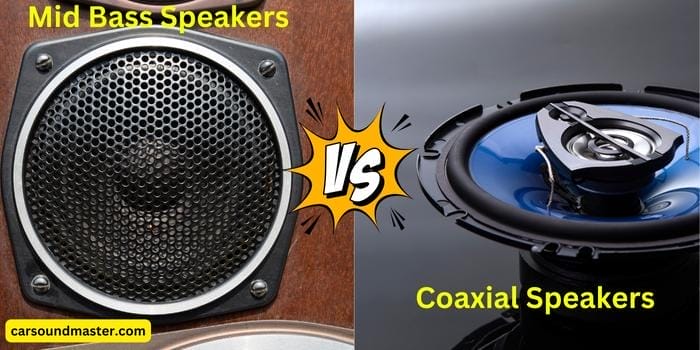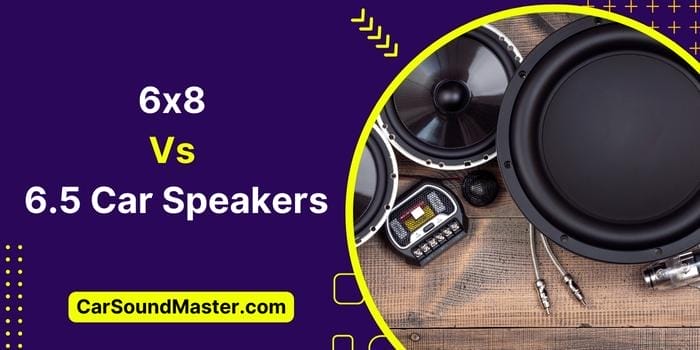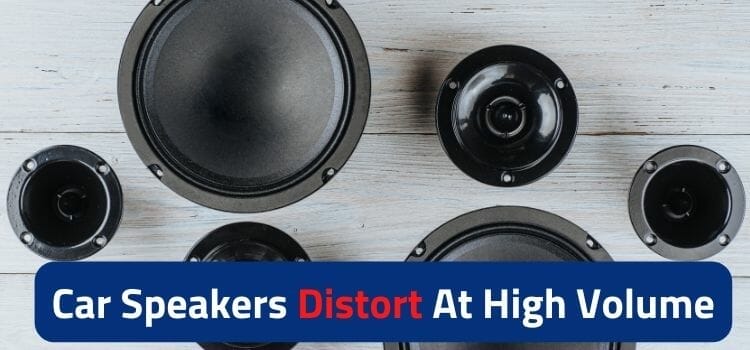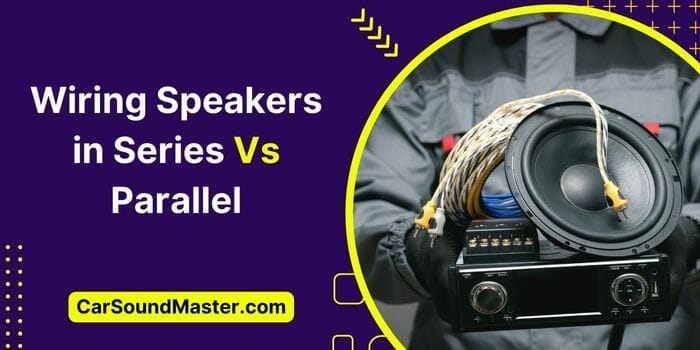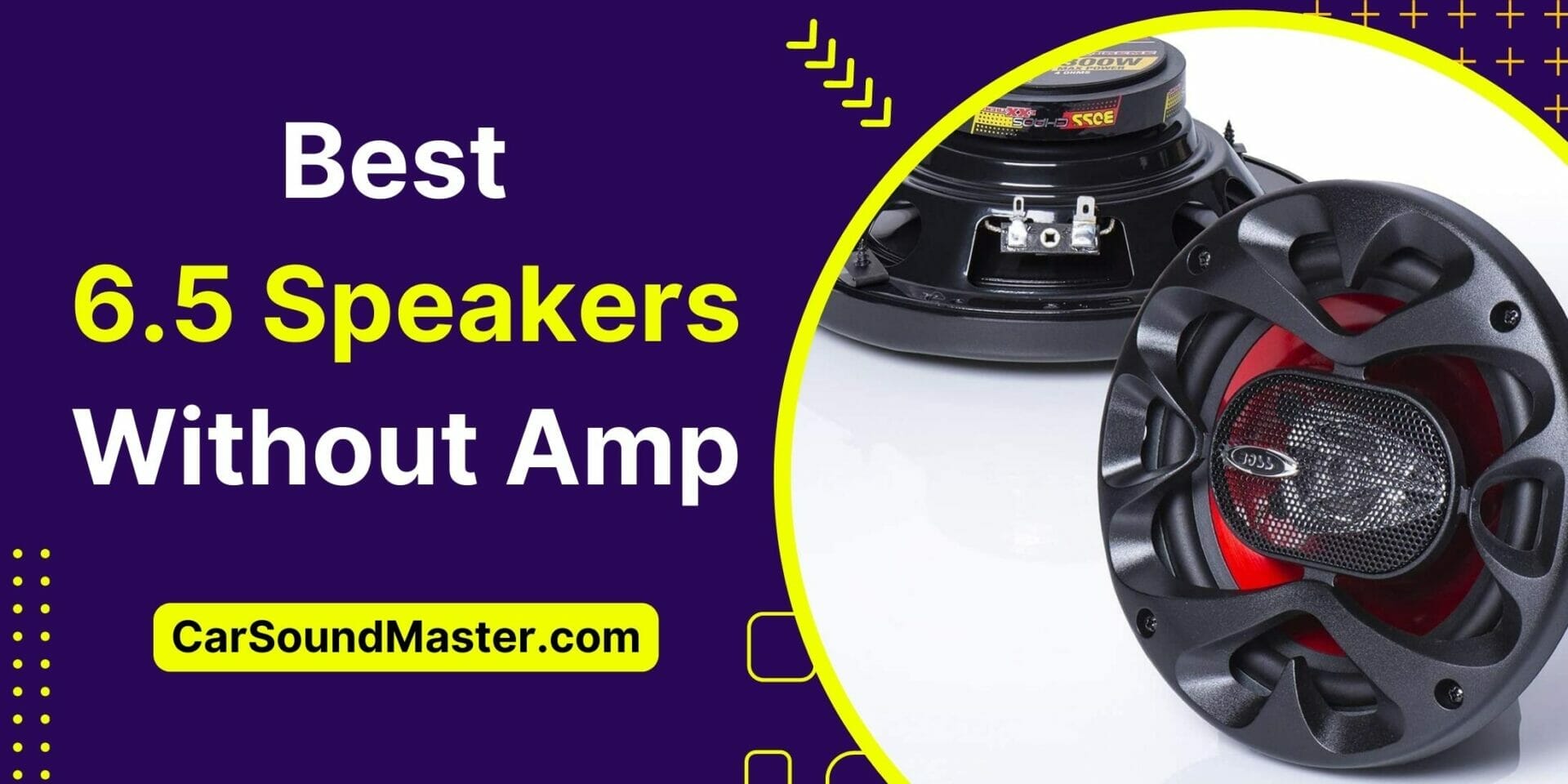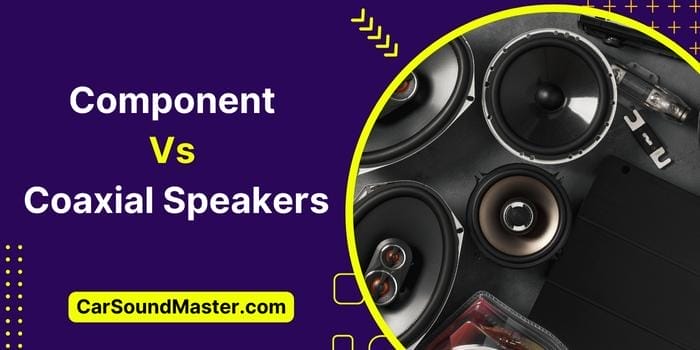Mid Bass Vs Coaxial Speakers – The Difference You Should Know!
One of the most straightforward things that so many, newbies I’d say, usually muss up is not understanding the difference between a full-range speaker and an individual driver. And asking things like “mid-bass vs coaxial speakers” is one big example of that.
Well, let me explain. A coaxial speaker is also called a full-range speaker because it has multiple drivers (2, 3, 4 … it varies) on a single axis, and it covers the full range of audible sound spectrum.
Whereas, the mid-bass is an individual driver that only produces the mid-range frequencies. It’s one chunk/component of what we call component speakers.
Listening to a song on mere mid-bass speakers means that you hear just the middle spectrum of the song’s overall frequencies – a disastrous dissatisfaction.
Still not getting it? Continue reading…
Mid Bass Vs Coaxial Speakers
There is no way I can make you fully understand the difference between a mid-bass/mid-range speaker and a coaxial but through a practical example. So let’s do it.
Understanding the Difference Via a Hands-on Experiment
Suppose you play a tune on your piano that involves pressing the keys “A” and “C” the most alongside all the other keys in somewhat manner too.
Here, the sound notes produced by pressing the key “A” are from the lowest region of the audible range (i.e. 27Hz), whereas the frequency coming out of “C” is from the highest extreme of the spectrum (i.e. 4186Hz). All the other keys in between would thus throw sound waves from the range between 27Hz and 4186Hz.
Now, however the audible frequency range of a human ear is 20Hz to 20KHz, let’s tweak it a bit for our hypothetical scenario.
For example, say the human audible range is 20Hz to 4200Hz for now. So when a person with such audible range listens to your (recorded) tune via a speaker, here’s how he/she will take it:
- If the person listens to the tune on a mid bass speaker: he/she will only hear the sound notes produced by the keys other than A and C; not even the notes produced by other keys with similar (or nearly similar) high highs of C and low lows of A.
- If the same tune is heard through a coaxial speaker: it will feel almost live-like and original. Not, maybe, 100% of all the notes but all the mid-range (keys except A and C) as well as most of the “A” and “C” keypresses, will also feel crisp and clear.
To completely understand why this happens, let’s go with an entirely elementary approach and apprehend a few absolute basics first.
What is a Speaker Driver?
A driver inside a speaker/loudspeaker is a mechanical component also known as a transducer. The sound produced by a speaker is actually the conversion of electrical signals (coming from an amp or stereo) into mechanical energy by the driver via the movement of air.
Types of Drivers/Transducers
Speaker drivers can be of different types and sizes with the most popular ones being the woofers and subwoofers, mid-range drivers, tweeters, and super tweeters. Each of them covers a different range of audible frequencies depending mainly on their sizes and thus produces a different type of sound.
For your understanding, here’s how they do:
Subwoofers
These are usually the largest of all the drivers available with diameters ranging from as small as 8 inches to up to 20” or even bigger. Their spacious sizes make for more air movements and thus these drivers produce sound notes from the extremely low region of the audible frequency range – also called bass/sub-bass.
General consumer-grade subwoofers are built to operate in a frequency spectrum of around 20Hz to 250Hz. For professional-level subs, the maximum they throw is anywhere around 70 to 80Hz only.
Woofers
Woofers come after the subwoofers. They flaunt a tad bit smaller sizes and operate in a frequency range of around 40 to 2KHz. The low-frequency sounds produced by them also make for the bass segment of the spectrum but these are not as deep as of subs.
Mid-range Drivers
Oftentimes, people confuse both woofers and tweeters with mid-range drivers. However, the notes produced by these lie anywhere between the 400 to 5KHz frequency range of the audible spectrum.
So there does lie an overlap, but the sounds by these drivers are neither deeper woofs nor spiky tweets but middle-ground bass.
Tweeters
Tweeters are very small speakers/drivers that don’t allow much air circulation and thus produce frequencies from the upper extreme of the audible spectrum.
They generally have a frequency range response of between 2KHz to 20KHz and make for a perfect soundscape when in conjunction with bass drivers.
Super Tweeters
The smallest of them all, super tweeters can even surpass the audible frequency range of a human ear by producing ultrasonic (>20KHz) notes. The lowest frequency they produce also reads over 2KHz so they are used in sound systems to produce the highest frequencies without any distortion.
What is a Mid Bass Speaker?
A speaker is either a combination of drivers built into one unit (known as a coaxial speaker) or a solo driver working in partnership with other speakers/drivers (known as a component speaker set) to cover the full frequency spectrum.
Mid bass speakers, popularly known as mid-range speakers (the 3rd type given above), are solo-driver compositions. As their name suggests, these speakers cover only the middle spectrum of the audible frequency range.
From that experiment at the start, it should be quite clear to you now why a mid bass speaker would only output the notes produced by keys other than A and C.
Those two keys make for the lowest and the highest extreme of the frequency range whereas a mid bass/mid-range speaker is designed to not allow any of those but just the notes from the middle range of the spectrum.
So both the tunes from keys “A” and “C” as well as any other key(s) with similar (extremely high or extremely low) frequency will never pass from a mid-range/mid bass speaker.
What is a Coaxial Speaker?
A coaxial speaker is one of the two universal car speaker types that offer a full range of audible sound spectrum frequencies from a single assembly. Coaxial speakers have got all the drivers and crossovers incorporated into a solo unit.
Generally, a standard coaxial speaker packs only two drivers i.e. a woofer (that makes more than half of the speaker’s circumference) and a tweeter (that emerges on top of its center) connected through a crossover device. This type of coaxial speaker is called a 2-way speaker.
There are also 3-way and 4-way speakers available with the former boasting an additional “mid-range driver” to the previous two, whereas the latter houses a “super tweeter” in addition to all the three.
You see? You get all the frequency ranges covered in a single unit, and thus you get an evenly filled soundstage.
Let’s get back to that experiment again. If you listen to that tune on a 2-way coaxial, you’d hear it like maybe 85 to 90% of the originally played one. But if you hear the same tune on a 3-way or 4-way, you’d feel more than accurate crisp in all the highs (the C octaves) and superb woofs in all the lows (the A octaves) as well as exceptional overall mid-range frequencies.
Coaxial speakers are nowadays the first-choice speakers of most vehicle manufacturers and come as the OEM stock standards in cars. They are easier to install, consume less power to work easily with your typical stereo, and are inexpensive as well – if we talk about their aftermarket mates.
There’s though so much more about them. So I’d suggest you check out “component vs coaxial speakers”, to know more and in detail about coaxial speakers.
Closing Thoughts
A “mid-bass vs coaxial speakers” contest is never ever there on the cards. A coaxial speaker is a full-fledged speaker on its own with the capability to cover almost the entire audible frequency range courtesy of its multi-driver build.
Whereas, all alone, a mid-range/mid-bass speaker is nothing. It’s just an individual driver that can only allow a very specified frequency range to pass through it. Unless it’s joined by the other drivers/individual speakers to make for a full-fledged frequency range response, listening to music on mere one mid-range speaker is a disastrous displeasure.
It will just throw out a portion of your favorite song – as in that experiment where you hear no highs and lows or the C & A octaves. And if you try to push it for all the frequencies, it will just eventually blow away.
So it’s almost impossible to set a mid-range speaker against a coaxial speaker as in that very sense, these two are completely apart things.
Nevertheless, if there’s a tweeter in conjunction with the mid-bass speaker, that very well makes for a full-fledged speaker (a component set) capable of taking on a coaxial.

